ARTA classics - New releases |
|
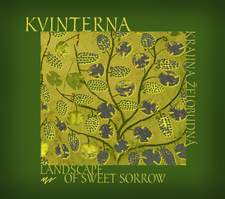
total time - 62:46
Old Moravian and Sephardic Ballads about Love, Sorrow, Hope and Faith
- Porque llorax 6:12
- Landscape of Sweet Sorrow 4:23

- Tres hermanicas 2:42
- A la una naci yo 5:29
- Yo me levantara / Poverty 5:52
- Crab-apple Tree 1:48
- Ir me quería / Mi suegra la negra 5:52

- Mary Went to a Convent 2:26
- Nacimiendo de Moxe 4:28

- Lamentation for a Poor Woman / Consagracion de Moxe 7:31
- Nani, nani 3:53
- Hardship / Madre, la mi madre 12:03

 KVINTERNA
KVINTERNA
Hana Blochova - vocal, harp, psalterium
Pavel Polasek - vocal, cornamuses, santur, chalumeaux, gemshorns, recorders, string psaltery, duochord, chord zither, bladder pipe, hurdy gurdy, folk bass, fujara (long overtone fipple flute)
guests:
Petr Wagner - viola da gamba
Marek Spelina - flutes
Marwan Soulieman - arabian lute (oud)
Vitezslav Janda - percussion
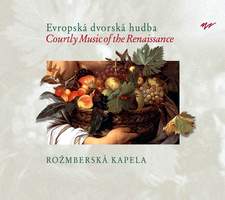
ROZMBERK CONSORT
-
The Court of Queen Elizabeth at London
- Thomas Morley: Now is the month of maying 0:55
- John Dowland: I come again 2:08
- Anonym: I smile to see how you devise 2:13
- Anonym: Maiden-Lane 1:13
- Anthony Holborn: Galiarde 1:38
- Anonym: Grimstock 1:38
The Court of the French King at Paris
- Claude Gervaise: Bransle simple 2:01
- Claude Gervaise: Pavana 1:54
- Pierre Francisque Caroubel: Bransle gay 1:10
- Thoinot Arbeau: Bransle l'Official 1:49
- Claude Gervaise: Bransle X 1:33
- Anonym: Bouffons 1:45
Music consorts of the German nobility
- Erasmus Widmann: Clara 1:49
- Michael Praetorius: Canarie 1:13

- Erasmus Widmann: Sophia 1:30
- Michael Praetorius: Bransle 1:49
Italian courtly music
- Mateo Rampolini: Bacco, bacco 1:36
- Adriano Banchieri: Fantasia 1:34
- Marco Cara: Io non compro piu speranza 1:46

- Anonym: La Montagnura 2:22
Music of the Golden Age in Spain
- Pedro Escobar: Paséisme aor' allá serrana 1:48
- Diego de Fernandes: De ser mal casáda 2:26
- Juan del Enzina: Villancico 2:37
- Juan del Enzina: Fata la parte 3:12
- Juan del Enzina: ?Si habrá en este baldrés? 2:27

Renaissance music in the Bohemian Lands
- Giovanni Giacomo Gastoldi: A lietta vieta 2:11
- Giovanni Giacomo Gastoldi: Baletti umori 1:32
- Valentin Haussmann: Tanz 1:18
- Jakob Regnart: Von nothen ist 1:38
- William Brade: Mascharada 1:26
- Valentin Haussmann: Tanz und nach tanz 1:28

- Anonym: Bergamasca 2:03
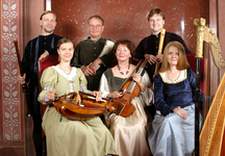 ROZMBERK CONSORT directed by Mario Mesany
ROZMBERK CONSORT directed by Mario Mesany
Eva Kaniakova: viola da braccio, saracen lute, gemshorns, crumhorns
Sarka Langerova-Hulova: viola da braccio, vocal, trumpet marine, scheitholt
Zbynka Solcova: harp, scheitholt, regal, bells, percussion
Mario Mesany: recorders, gemshorns, crumhorns, wind-chest shawm, bladder pipe, hurdy-gurdy, bag-pipe, xylophone
Pavel Polasek: recorders, gemshorns, crumhorns, bombard, wind-chest shawm, bladder pipe, percussion
Libor Zidek: vocal, crumhorns
and guests:
Vera Mikulaskova: viola da gamba
Frantisek Pok: cornett, bag-pipe
Michal Verner: recorders, gemshorns, crumhorns, curtal
The original Rozmberk Consort was active from 1552 to 1602 at the Castle in Cesky Krumlov (Krumau, in German) and then in Trebon, and it contributed to the glory of the south Bohemian court of the brothers Vilem and Petr Vok of Rozmberk from the mid-sixteenth to the early seventeenth centuries.
The modern Rozmberk Consort was founded in 1974 by Frantisek Pok. In the thirty years of its existence a number of excellent musicians have played in the ensemble, it has undergone a change of generations, and has survived even after the departure of its founder and long term artistic director. (Events that have in other cases led to the decline and break-up of exceptionally successful music groups.) At the time of its founding it was unique in the country. Today, as well, when the interpretation of early music has become more widespread, it maintains its uniqueness thanks to its rich experience, enduring contacts with ensembles abroad (made when performing at international early-music festivals), and owing to its high professional standards. These standards stem from the fact that all its members are professional musicians working in major ensembles in Prague (including the Prague Radio Symphony Orchestra, the State Opera, and the Karlin Music Theatre). The players are united by an interest in early music and a willingness to master several now unusual instruments, which in earlier centuries was something taken for granted.
The musical versatility and flexibility both of the individual members and of the ensemble as a whole enable them as interpreters to cover a diverse range of instrumental and vocal music of the Middle Ages and the Renaissance. The range of instruments of the Rozmberk Consort is remarkable, comprising about forty string, wind, keyboard, and percussion instruments. They are used in various combinations to evoke aural pictures of music of different eras. Some of the instruments come from the Pok workshop; others are replicas of historical instruments by specialized makers.
The arrangements of the compositions respect the rules of early-music interpretation. They also put emphasis on timbre, variety, and original emotional effect. They resonate with natural musicality, which is undoubtedly appreciated by listeners today as much as it was five hundred years ago. In this way the Rozmberk Consort has secured for itself the lasting favour of audiences young and old and of different educational backgrounds. Regardless of its success on tours abroad it is just as certain to create an unforgettable atmosphere at an educational concert in some remote corner of the Czech Republic as it is at a renowned international festival.
Apart from its own vinyl and CD recordings the ensemble has recorded for European radio stations, including ORF in Austria, WRD, Deutschland Radio Berlin, Radio Nacional de Espana, Greek Radio, and, repeatedly, for Czechoslovak and, later, Czech Radio.
Together with Czech Television the Rozmberk Consort has made a few programmes of its own (for example, in the "Best of the Classics" series), and has recorded soundtracks for Czech and foreign films.
Touring abroad and performing at festivals has taken the Rozmberk Consort to Greece (1982, 1984, and 1988), Sweden (1987 and 1991), Spain (1995, 1998, and 2001), Malta (1996), Switzerland (1989, 1993, 1995, and 1998), Wales (1996), and Luxembourg (2004).
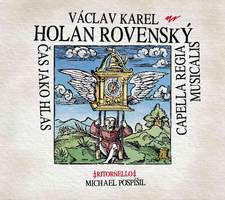
- The time has come to be merry 2:03
- Angel of God 1:59
- Hark, from the Heavenly Court 1:39
- Mary, grant us thy permission 1:49
- O Lord! 2:00
- Mary, a Noble Field 1:30

- Sing, Angels 2:22
- The Radiant Sun 1:46
- Hark my Soul 1:27

- O King most High 1:50
- To you, now Newlywed 4:24
- There is not in this World 1:18
- Pastime Promenade 2:56
- O ye who walk the path 2:49
- Blessed Virgin, wherefore sighest thou? 2:23
- Surrexit Christus hodie 2:10
- Triumph, triumph, rejoice 1:45

- The Mother Stood Rejoicing 1:09
- Lo in this time of spring 3:41
- Days of May, Voices of Joy 2:22
- Hurry with joy 1:53
- Pentecost 1:57
- What shall I say good Jesus? 2:32
- O Wonderful Jesus 3:34
- Where are we going in such haste? 2:49
- Where, oh where are you Emperor? 2:02
- All the People of the World 2:31

- In thy Name my Jesus 3:33

|
Blazena Pechackova - vocal, violin; Hana Blazikova - vocal, harp; Katerina Dolezalova - vocal, harp; Jan Mikusek - vocal, dulcimer; Marc Niubo - vocal; Radim Vondracek - vocal; Michael Pospisil - vocal, organ positive, flageolet; Stefan Sukup - flute, cornetto; Radovan Vasina - cornetto; Richard Seda - cornetto, recorder, drum; Ondrej Sokol - sackbut; Jan Klimes - dulcian; Hana Flekova - viola da gamba; Miloslav Student - archlute, viola da gamba; Jan Krejca - theorbo, Baroque guitar; Vladimir Roubal - organ; Tomas Reindl - kettle drums.
Hollan's hymnal CAPELLA REGIA MUSICALIS (1693/94) is unique in the world, for several important reasons. Its relatively large format (A4) was rarely used anywhere. It was so big that it required a music stand. It was not, however, meant only to remain standing in the church as a counterpart to the liturgical books on the altar; it was intended for use in processions, schools, at table in peoples' homes, and at the bedside (for morning, evening, and wedding songs). Some of the songs seem to have come running in from a small grove, park, garden, or field-path, or, conversely, running back to them. It contains songs for a small Bohemian Ordinary, next to evensongs, songs for the congregation, solo 'arias' for professionals - the acolytes. Some of the songs allow the accompanying organist to 'shine'; others have been furnished much less modestly with parts not just for the organ but for many other instruments as well. No other nation in the world can boast such an accomplishment.
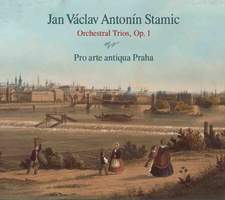
Total time - 68:20
re-release with the new slip-case
Orchestral Trios, Op.1
- Sonata I in C
- Sonata II in A
- Sonata III in F
- Sonata IIII in D
- Sonata V in B
- Sonata VI in G
 Pro arte antiqua Praha
Pro arte antiqua Praha
(on period instruments)
Vaclav Navrat, Jan Simon - violins, Petr Hejny - violoncello, Ondrej Balcar - double bass, Ales Barta - harpsichord
The extensive body of the work of Jan Vaclav Stamic (1717 - 1757) was being assembled before World War II, and other works were added to it after the war, based on copies of the destroyed originals. A number of symphonies, however, remain missing. There are 58 symphonies in existence and 10 orchestral trios, of which the first six were published in Paris in 1755, as Op. 1, under the title Six Sonates a trois parties concertantes. The trios, presented here in a version for chamber orchestra, can be located stylistically somewhere between chamber music and orchestral music, though it is classified among symphonic works (the sinfonie of Stamic's day). It comprises six compositions in sonata form, which have been preserved in the original versions as first published. Each trio consists of four movements, including a minuet and trio as the third movement, followed by a prestissimo finale. They are all in major keys and share stylistic purity, clarity of motif, concise compositional conception of the individual movements, as well as augmentation and emphasis of the second subject. Thanks to Stamic, too, the consistent inclusion of the minuet in the sonata form was also introduced into symphonic works of the 18th and 19th centuries, where it became firmly rooted.